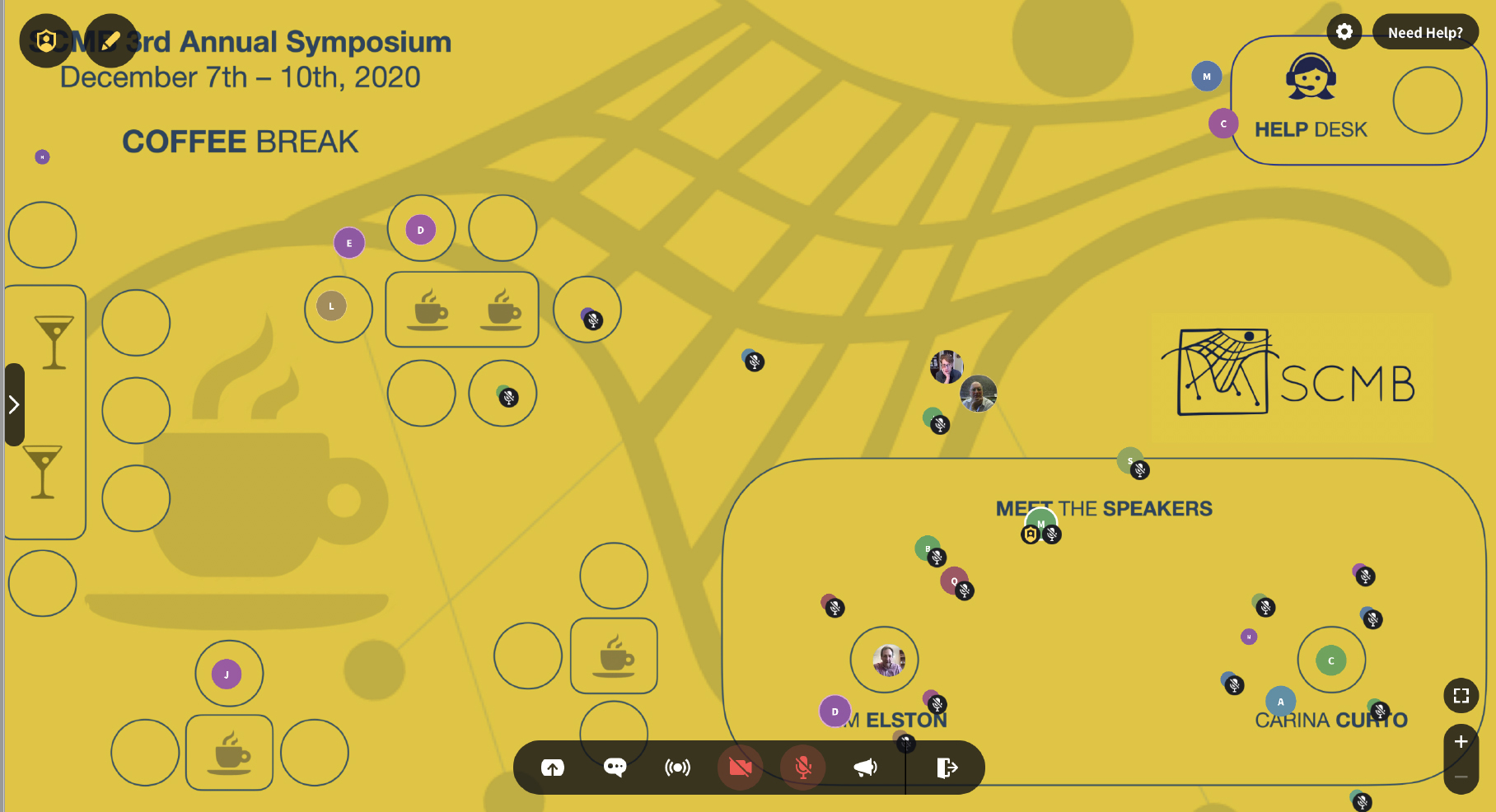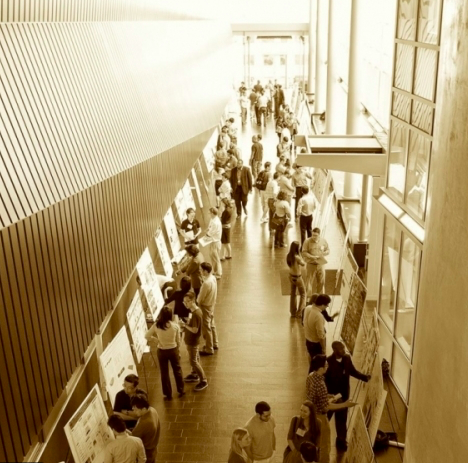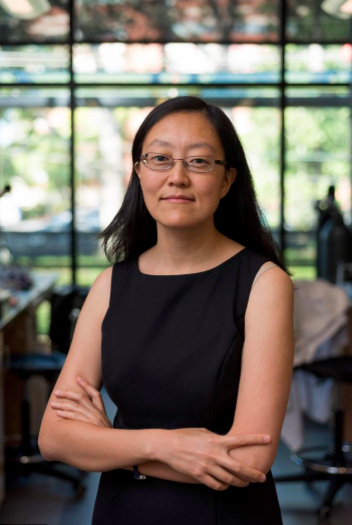The Southeast Center for Mathematics and Biology (SCMB), which is headquartered at Georgia Tech, sits squarely at the critical intersection of two disciplines — and it has been collaborating and conducting research across mathematics and biosystems for the past two years.
“Something we’ve all experienced over the past year is the importance of mathematical modeling,” says SCMB Director Christine Heitsch, a professor in the School of Mathematics with courtesy appointments in the Schools of Biological Sciences, and Computational Science and Engineering. “The better the interaction between mathematics and biology, the better the quality of the data modeling and analysis.”
Along with bringing mathematics and biosystems into sharp focus, the pandemic year of 2020 has also continuously evolved how we meet to share knowledge with one another.
SCMB hosted its 3rd Annual Symposium December 7-10, 2020 — marking the group’s first virtual annual meeting. The previous two symposia featured plenary talks and poster sessions at the Marcus Nanotechnology Building. This time, online sessions ran from noon to 2 p.m. EST each day. This year’s virtual environment featured junior researchers showcasing their work at the frontiers of the math-bio interface via screenshare. There was also a lively virtual session for contributed posters, three engaging panels focusing on cross-disciplinary communication from different perspectives, and a closing plenary talk.
Created in 2018, SCMB is funded by the National Science Foundation and the Simons Foundation. It is headquartered at Georgia Tech, and has six partner institutions around the southeast --- ORNL, Clemson, Duke, Florida, South Florida, and Tulane. SCMB is one of four NSF-Simons Research Centers for Mathematics of Complex Biological Systems. The other Centers are located at Harvard University, the University of California, Irvine, and Northwestern University.
Like several other research centers at Georgia Tech, SCMB stands as a truly interdisciplinary effort, with Hang Lu, Love Family Professor in the School of Chemical and Biomolecular Engineering, serving as SCMB Associate Director.
Seed projects at SCMB take advantage of a unique structure of pairing scientists in non-traditional, cross-disciplinary teams of principal investigators and junior researchers. The results promise a wider range of perspectives on scientific problems and potential solutions.
There are seven studies underway at SCMB, with the teams evenly split between mathematics and biosystems researchers — not just at the senior personnel (SP) level, but also among the postdoctoral researchers and graduate students who are an integral part of the Center.
Current research projects include using math models to learn more about DNA and RNA interaction — and where breaks in that connection could lead to genetic disorders — as well as how biological agents exploit disorder and randomness to survive their treks through hosts. One SCMB research team is investigating RNA structural ensembles in evolution, while another is investigating how stem cells pattern within colonies due to specific cell to cell communication.
Q&A with the Southeast Center for Mathematics and Biology
How would you explain the "math-biology interface" to the layperson? What's the connection between mathematical areas of study like geometry and topology to, say, molecular biology or genetics?
Christine Heitsch:
We usually refer to it as the “math-bio interface.” The reason is because the mathematical sciences are really broad, including optimization, statistics, parts of computer science, as well as the areas that we think of as more classic core mathematics.
“Bio” certainly includes biology and biomedical engineering but also physics, chemistry and chemical engineering, so we use the shortened form to indicate the breadth of studies here too.
Hang Lu:
Molecules, networks of genes, and images (of cells, tissues, organisms, and animal behavior) all have shapes, and interestingly shapes and changes in shapes can tell us a lot about function and dysfunction. Fields like geometry and topology are equipped with dealing with these things.
Christine Heitsch:
A fundamental premise for our center is “theory plus data.” The idea is that the math side brings the theoretical expertise, and the bio side brings the experimental expertise. These two domains of expertise meet at the interface that is the modeling and analysis of the data.
In some sense, any researcher is fundamentally seeking to better understand the world. We differ in the range and types of tools used, and in the aspects of the problems that we find interesting.
Geometry is fundamentally the study of shapes as, in some sense, is molecular biology. But a molecular biologist traditionally has very different ways of thinking about shapes, experimenting with the shapes of interest, than a geometer does. Classically, a molecular biologist will use physical experiments, whereas a geometer will use thought experiments. Now, though, both of them are increasingly likely to use computational experiments, especially when collaborating with each other.
Is this a "big data" approach to math and biological sciences? Are you using computational models to search for patterns or connections in the biological sciences?
Heitsch:
We are always searching for patterns and connections. However, the phrase “big data” has a certain resonance in the common usage, which is not the best description of our approaches.
One of our senior personnel, Matthew Torres, an associate professor at the School of Biological Sciences, said at the very beginning of this initiative that his interest wasn't in having someone do a better analysis of his current data. Rather, he said, the greatest advantage to a biologist in participating in efforts like this is gaining a new way to ask questions that weren't known before. Matt put a huge effort into the planning and execution of this year’s Symposium, so he’s clearly invested in the center’s success. He also shared how excited he was about the recent results from his SCMB collaboration, so stay tuned for further developments on that front.
The structure for your research teams is designed to make sure there's a math principal investigator and a bio principal investigator, along with a bio graduate research assistant and a math postdoctoral scholar, on every project. I know this is designed to share knowledge and train practitioners of one discipline in the foundations of the other discipline. How has that been working out since SCMB opened?
Heitsch:
Even better than we had hoped! That’s one of the reasons our Symposium this week focused on exactly this critical skill of ``interactional expertise’’ in cross-disciplinary collaborations. It really does seem to be the secret sauce for success.
The way that I keep track of it in my head is by picturing a square. You always have the vertical/disciplinary sides, which are the standard senior mentor and junior trainee relationships. What SCMB is doing is bringing in those horizontal, cross-disciplinary connections — the bio grad students interacting with math postdocs, the senior personnel engaging with each other — as well as the diagonal connections being forged.
In that vein, one of the things that the center is always trying to communicate is that there’s great value to studying more complimentary discipline. If you do, then you have some groundwork to interact with experts. You won’t necessarily develop research expertise, but you’ll have some fundamental vocabulary. A little bit of fluency in another discipline can go a very long way.
As an SCMB trainee , how do you like the interdisciplinary diversity within the center’s research teams?
Hector Banos, SCMB mathematics postdoctoral junior researcher:
I really enjoy it. I am trying to develop a micro-evolutionary model to describe allele variation in tRNA (transfer ribonucleic acid). Certainly, it’s something new to me, but being able to get constant feedback from both the math and the bio sides really helps and keeps it interesting and relevant.
In our seed project, we have a nice collaborative system. I get to participate in the Bio PI lab's meetings, and I am treated as another [within the] cohort. They also are very welcoming and address any questions or ‘inquietudes’ I have regardless of the type of question. Sometimes it may be a little frustrating not being able to keep up with all the concepts and techniques, but I guess that is part of the learning curve for someone without formal bio training, and they help me with that. I also try to provide my perspective from the math side. All these interactions have led to great discussions.
How has this arrangement helped you with your research?
Massively. Being able to collaborate with biologists on a daily basis has changed my perspective on math and biology. I became more aware of the challenges, techniques, and topics in the area. I have been able to communicate better with other biologists and bio-mathematicians. Also, being part of a center enhances the whole experience. We get to see different projects and talk to experts on math and biology. The center organizes activities that promote interactions within the fields. I am getting more comfortable in terms of biology and I think that is something someone who does math-biology needs to work on, so I am getting there.
Can you give a status report on progress within the research teams?
Hang Lu:
In all projects, the bio researchers are now exposed to a whole new set of tools and ways of thinking. The multitudes of center activities certainly lowered the barriers for bio researchers to interact with mathematicians, particularly their partners. Most pairs have moved to defining better questions to ask and address together, which is exciting.
Heitsch:
We had our 2nd Annual Symposium in February 2020 which was coupled with the second Advisory Board meeting. All seven pairs of junior researchers got up in front of these senior experts and presented a unified picture of the progress made on each of their seed projects. The Advisory Board was definitely pleased with the center’s progress overall. Internally we think things are going quite well, and we’re delighted that that was validated by outside experts.
How hard has it been to get these seven research projects up and running since SCMB was founded?
Heitsch:
Initially, the research aspect was about as seamless as it could be.
By design the organization of the Center was intended to be very nimble, because we knew we would need to quickly ramp up on a number of research projects. It was great to see it working out as planned.
Recently, though, we’ve had to make some adjustments. A significant changes in plans was the postponement of our “postdocs in residence” program planned for May 2020. The four off-site postdocs (distributed around our partner institutions in the Southeast) were going to join the three GT ones in being embedded in the research labs of their seed project collaborators for almost a month. We’re still hoping to reschedule so that the math PhDs really get an opportunity to experience the data side — this “theory plus data” balancing act.
On a more positive note, the bio grad students did have an opportunity to experience the theory side through a new “Math for Bio” graduate student course that was offered in spring 2020. A current SCMB postdoc, Daniel Cruz, and I taught that class, and the students have told us what a positive experience it was. They felt like they gained an understanding of some mathematics they had not previously been exposed to in a way that was accessible to them, and could be useful in the future.
What kinds of applications could result from this research in the next five to ten years? Where could math and biological sciences go from here?
Hang Lu:
The Center addresses questions from molecular scale all the way to organism behavior. In five to ten years, the Center will be looking at these questions from unconventional angles; that is, making predictions about biological functions and figuring out mechanisms of actions in proteins, RNA/DNA, designing molecular transport and cellular differentiation patterns, detecting subtle changes in organism aging process, and making better biomimetic robots.
Heitsch:
I’m not a good prognosticator. I will say that one thing we’ve seen over the past year is how important the modeling and analysis of biosystems can be. The level of interaction between math theory and bio data can have profound implications for our lives. It’s really been a lesson in the importance of researchers who may not necessarily be experts in both sides but who can collaborate with experts from the other side.
For SCMB, this all circles back to our “theory plus data” approach. There are a lot of people who have expertise in math and a lot with expertise in bio, and if SCMB can facilitate their interacting with each other, then really great things can come of this. We’re already seeing how these new collaborations --- as well as all the intra-center interactions --- are challenging us to think about our projects in new ways and helping to train the next generation of cross-disciplinary researchers.
When we went to New York (in February 2018) to make the pitch for the center, somebody asked, “How will you know it’s been a success?”
It’s similar to the question you’re asking. By that point I was a little slap-happy, so I said, “when a biologist sitting in the audience thinks, ‘Oh expletive, I need to find a mathematician to collaborate with.’”
We won’t necessarily see the full impact directly, but what we’re expecting to do is break new ground in our seed project areas. Throw down the gauntlet — this is the level of math-bio interaction needed to achieve these kinds of results.
For More Information Contact
Renay San Miguel
Communications Officer II
College of Sciences
404-894-5209






